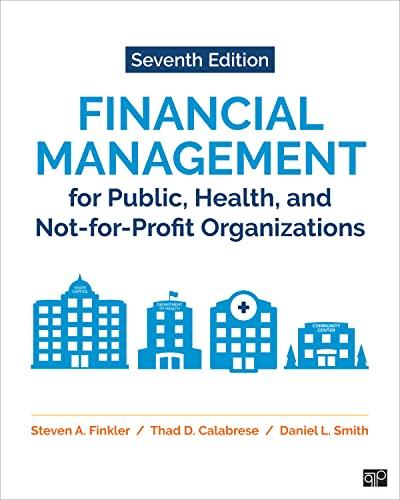
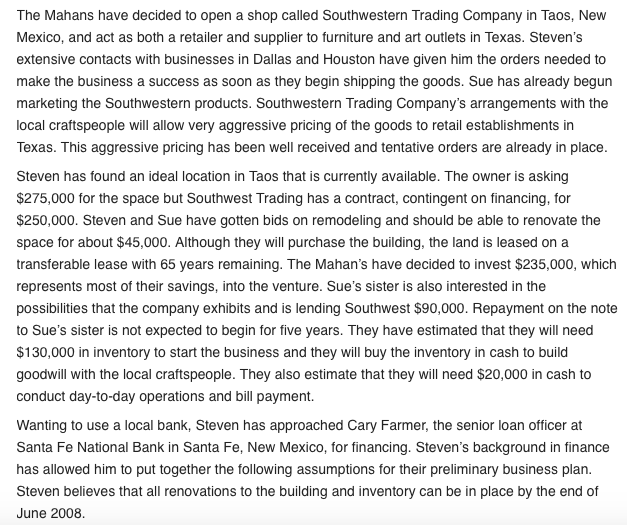
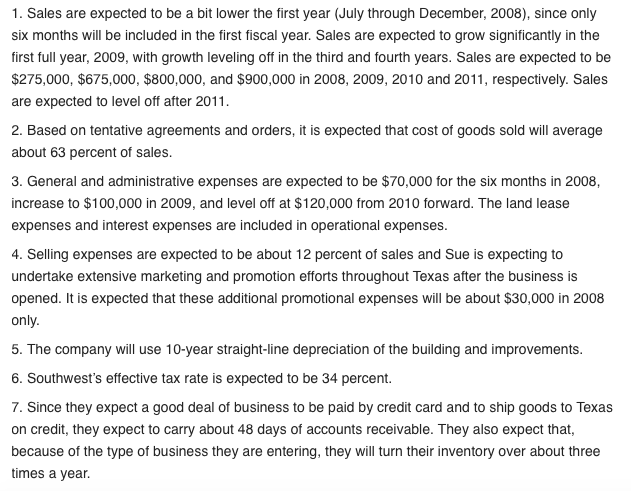
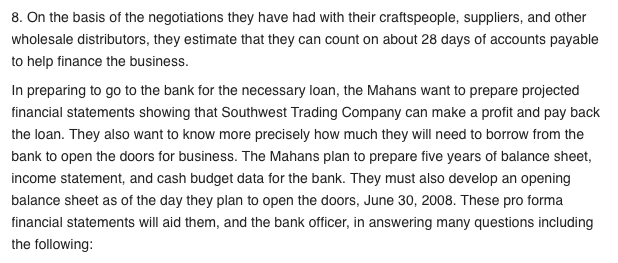
Create 4 pro formas : Proformas should include a beginning point at 06/30/08 with a 6-month stub-year (BE SURE TO TAKE NOTE THE EXERCISE HAS A STUB YEAR - this impacts your pro-forma calculations) , then YE 12/31/08, 12/31/09, 12/31/10, 12/31/11, 12/31/12, & 12/31/13
***DO INCOME STATEMENT PROFORMA 1st ***
*** USING THESE CATEGORIES***
starting with 06/30/08 ignore the dates below.
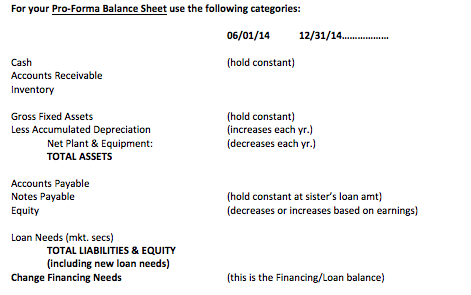
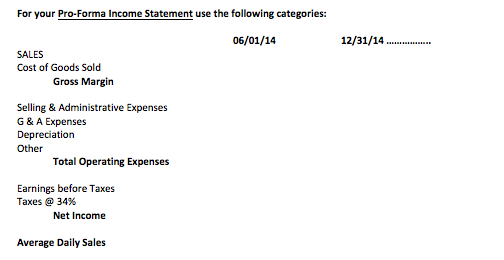
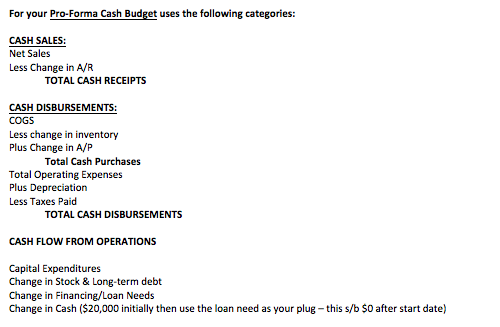
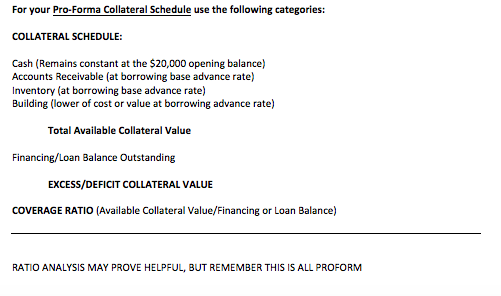
Southwest Trading Company, Taos, New Mexico. Summer is approaching and Steven and Sue Mahan have finally decided that their idea of a successful Southwest furniture, art, and jewelry trading company has come of age. They know that summer is a popular tourist time in New Mexico and could be the best time to start this new business. The Mahans have had a long- time interest in Southwestern art and furniture. Steven graduated from college with an economics degree about 15 years ago and received his M.B.A in finance a few years later. He has been working in Dallas, Texas, as the controller of a major wholesale distributor company for many years. His wife, Sue, who will be a full partner in the business, spent the first 10 years of her career in retail sales. Over the last several years she has assumed more administrative duties for the group she works with. Steven and Sue know they bring the expertise and skill to run a successful business, but to ensure success they have been researching the market for over five years. They also know that they must be very careful and thoroughly research the business and industry they are pursuing. They have traveled extensively to New Mexico and have spent a good deal of time getting to know the local artists (primarily ski bums). They have found that there is a great demand for Southwestern furniture in Texas and the Southwest, and prices are high. Through their contacts with the local craftspeople they have found that many of them would like a reliable source for displaying and selling their goods. They have been able to make tentative arrangements with a large and dependable group to supply the furniture and art pieces they will need to run the business. The Mahans have decided to open a shop called Southwestern Trading Company in Taos, New Mexico, and act as both a retailer and supplier to furniture and art outlets in Texas. Steven's extensive contacts with businesses in Dallas and Houston have given him the orders needed to make the business a success as soon as they begin shipping the goods. Sue has already begun marketing the Southwestern products. Southwestern Trading Company's arrangements with the local craftspeople will allow very aggressive pricing of the goods to retail establishments in Texas. This aggressive pricing has been well received and tentative orders are already in place. Steven has found an ideal location in Taos that is currently available. The owner is asking $275,000 for the space but Southwest Trading has a contract, contingent on financing, for $250,000. Steven and Sue have gotten bids on remodeling and should be able to renovate the space for about $45,000. Although they will purchase the building, the land is leased on a transferable lease with 65 years remaining. The Mahan's have decided to invest $235,000, which represents most of their savings, into the venture. Sue's sister is also interested in the possibilities that the company exhibits and is lending Southwest $90,000. Repayment on the note to Sue's sister is not expected to begin for five years. They have estimated that they will need $130,000 in inventory to start the business and they will buy the inventory in cash to build goodwill with the local craftspeople. They also estimate that they will need $20,000 in cash to conduct day-to-day operations and bill payment. Wanting to use a local bank, Steven has approached Cary Farmer, the senior loan officer at Santa Fe National Bank in Santa Fe, New Mexico, for financing. Steven's background in finance has allowed him to put together the following assumptions for their preliminary business plan. Steven believes that all renovations to the building and inventory can be in place by the end of June 2008 1. Sales are expected to be a bit lower the first year (July through December, 2008), since only six months will be included in the first fiscal year. Sales are expected to grow significantly in the first full year, 2009, with growth leveling off in the third and fourth years. Sales are expected to be $275,000, $675,000, $800,000, and $900,000 in 2008, 2009, 2010 and 2011, respectively. Sales are expected to level off after 2011. 2. Based on tentative agreements and orders, it is expected that cost of goods sold will average about 63 percent of sales. 3. General and administrative expenses are expected to be $70,000 for the six months in 2008, increase to $100,000 in 2009, and level off at $120,000 from 2010 forward. The land lease expenses and interest expenses are included in operational expenses. 4. Selling expenses are expected to be about 12 percent of sales and Sue is expecting to undertake extensive marketing and promotion efforts throughout Texas after the business is opened. It is expected that these additional promotional expenses will be about $30,000 in 2008 only. 5. The company will use 10-year straight-line depreciation of the building and improvements. 6. Southwest's effective tax rate is expected to be 34 percent. 7. Since they expect a good deal of business to be paid by credit card and to ship goods to Texas on credit, they expect to carry about 48 days of accounts receivable. They also expect that, because of the type of business they are entering, they will turn their inventory over about three times a year. 8. On the basis of the negotiations they have had with their craftspeople, suppliers, and other wholesale distributors, they estimate that they can count on about 28 days of accounts payable to help finance the business. In preparing to go to the bank for the necessary loan, the Mahans want to prepare projected financial statements showing that Southwest Trading Company can make a profit and pay back the loan. They also want to know more precisely how much they will need to borrow from the bank to open the doors for business. The Mahans plan to prepare five years of balance sheet, income statement, and cash budget data for the bank. They must also develop an opening balance sheet as of the day they plan to open the doors, June 30, 2008. These pro forma financial statements will aid them, and the bank officer, in answering many questions including the following: For your Pro-Forma Balance Sheet use the following categories: 06/01/14 12/31/14......... ( (hold constant) Cash Accounts Receivable Inventory Gross Fixed Assets Less Accumulated Depreciation Net Plant & Equipment: TOTAL ASSETS (hold constant) (increases each yr.) (decreases each yr.) Accounts Payable Notes Payable Equity (hold constant at sister's loan art) (decreases or increases based on earnings) Loan Needs (mkt. secs) TOTAL LIABILITIES & EQUITY (including new loan needs) Change Financing Needs (this is the Financing/Loan balance) 12/31/14 For your Pro-Forma Income Statement use the following categories: 06/01/14 SALES Cost of Goods Sold Gross Margin Selling & Administrative Expenses G&A Expenses Depreciation Other Total Operating Expenses Earnings before Taxes Taxes @ 34% Net Income Average Daily Sales For your Pro-Forma Cash Budget uses the following categories: CASH SALES: Net Sales Less Change in A/R TOTAL CASH RECEIPTS CASH DISBURSEMENTS: COGS Less change in inventory Plus Change in A/P Total Cash Purchases Total Operating Expenses Plus Depreciation Less Taxes Paid TOTAL CASH DISBURSEMENTS CASH FLOW FROM OPERATIONS Capital Expenditures Change in Stock & Long-term debt Change in Financing/Loan Needs Change in Cash ($20,000 initially then use the loan need as your plug - this s/b $0 after start date) For your Pro-Forma Collateral Schedule use the following categories: COLLATERAL SCHEDULE: Cash (Remains constant at the $20,000 opening balance) Accounts Receivable (at borrowing base advance rate) Inventory (at borrowing base advance rate) Building (lower of cost or value at borrowing advance rate) Total Available Collateral Value Financing/Loan Balance Outstanding EXCESS/DEFICIT COLLATERAL VALUE COVERAGE RATIO (Available Collateral Value/Financing or Loan Balance) RATIO ANALYSIS MAY PROVE HELPFUL, BUT REMEMBER THIS IS ALL PROFORM Southwest Trading Company, Taos, New Mexico. Summer is approaching and Steven and Sue Mahan have finally decided that their idea of a successful Southwest furniture, art, and jewelry trading company has come of age. They know that summer is a popular tourist time in New Mexico and could be the best time to start this new business. The Mahans have had a long- time interest in Southwestern art and furniture. Steven graduated from college with an economics degree about 15 years ago and received his M.B.A in finance a few years later. He has been working in Dallas, Texas, as the controller of a major wholesale distributor company for many years. His wife, Sue, who will be a full partner in the business, spent the first 10 years of her career in retail sales. Over the last several years she has assumed more administrative duties for the group she works with. Steven and Sue know they bring the expertise and skill to run a successful business, but to ensure success they have been researching the market for over five years. They also know that they must be very careful and thoroughly research the business and industry they are pursuing. They have traveled extensively to New Mexico and have spent a good deal of time getting to know the local artists (primarily ski bums). They have found that there is a great demand for Southwestern furniture in Texas and the Southwest, and prices are high. Through their contacts with the local craftspeople they have found that many of them would like a reliable source for displaying and selling their goods. They have been able to make tentative arrangements with a large and dependable group to supply the furniture and art pieces they will need to run the business. The Mahans have decided to open a shop called Southwestern Trading Company in Taos, New Mexico, and act as both a retailer and supplier to furniture and art outlets in Texas. Steven's extensive contacts with businesses in Dallas and Houston have given him the orders needed to make the business a success as soon as they begin shipping the goods. Sue has already begun marketing the Southwestern products. Southwestern Trading Company's arrangements with the local craftspeople will allow very aggressive pricing of the goods to retail establishments in Texas. This aggressive pricing has been well received and tentative orders are already in place. Steven has found an ideal location in Taos that is currently available. The owner is asking $275,000 for the space but Southwest Trading has a contract, contingent on financing, for $250,000. Steven and Sue have gotten bids on remodeling and should be able to renovate the space for about $45,000. Although they will purchase the building, the land is leased on a transferable lease with 65 years remaining. The Mahan's have decided to invest $235,000, which represents most of their savings, into the venture. Sue's sister is also interested in the possibilities that the company exhibits and is lending Southwest $90,000. Repayment on the note to Sue's sister is not expected to begin for five years. They have estimated that they will need $130,000 in inventory to start the business and they will buy the inventory in cash to build goodwill with the local craftspeople. They also estimate that they will need $20,000 in cash to conduct day-to-day operations and bill payment. Wanting to use a local bank, Steven has approached Cary Farmer, the senior loan officer at Santa Fe National Bank in Santa Fe, New Mexico, for financing. Steven's background in finance has allowed him to put together the following assumptions for their preliminary business plan. Steven believes that all renovations to the building and inventory can be in place by the end of June 2008 1. Sales are expected to be a bit lower the first year (July through December, 2008), since only six months will be included in the first fiscal year. Sales are expected to grow significantly in the first full year, 2009, with growth leveling off in the third and fourth years. Sales are expected to be $275,000, $675,000, $800,000, and $900,000 in 2008, 2009, 2010 and 2011, respectively. Sales are expected to level off after 2011. 2. Based on tentative agreements and orders, it is expected that cost of goods sold will average about 63 percent of sales. 3. General and administrative expenses are expected to be $70,000 for the six months in 2008, increase to $100,000 in 2009, and level off at $120,000 from 2010 forward. The land lease expenses and interest expenses are included in operational expenses. 4. Selling expenses are expected to be about 12 percent of sales and Sue is expecting to undertake extensive marketing and promotion efforts throughout Texas after the business is opened. It is expected that these additional promotional expenses will be about $30,000 in 2008 only. 5. The company will use 10-year straight-line depreciation of the building and improvements. 6. Southwest's effective tax rate is expected to be 34 percent. 7. Since they expect a good deal of business to be paid by credit card and to ship goods to Texas on credit, they expect to carry about 48 days of accounts receivable. They also expect that, because of the type of business they are entering, they will turn their inventory over about three times a year. 8. On the basis of the negotiations they have had with their craftspeople, suppliers, and other wholesale distributors, they estimate that they can count on about 28 days of accounts payable to help finance the business. In preparing to go to the bank for the necessary loan, the Mahans want to prepare projected financial statements showing that Southwest Trading Company can make a profit and pay back the loan. They also want to know more precisely how much they will need to borrow from the bank to open the doors for business. The Mahans plan to prepare five years of balance sheet, income statement, and cash budget data for the bank. They must also develop an opening balance sheet as of the day they plan to open the doors, June 30, 2008. These pro forma financial statements will aid them, and the bank officer, in answering many questions including the following: For your Pro-Forma Balance Sheet use the following categories: 06/01/14 12/31/14......... ( (hold constant) Cash Accounts Receivable Inventory Gross Fixed Assets Less Accumulated Depreciation Net Plant & Equipment: TOTAL ASSETS (hold constant) (increases each yr.) (decreases each yr.) Accounts Payable Notes Payable Equity (hold constant at sister's loan art) (decreases or increases based on earnings) Loan Needs (mkt. secs) TOTAL LIABILITIES & EQUITY (including new loan needs) Change Financing Needs (this is the Financing/Loan balance) 12/31/14 For your Pro-Forma Income Statement use the following categories: 06/01/14 SALES Cost of Goods Sold Gross Margin Selling & Administrative Expenses G&A Expenses Depreciation Other Total Operating Expenses Earnings before Taxes Taxes @ 34% Net Income Average Daily Sales For your Pro-Forma Cash Budget uses the following categories: CASH SALES: Net Sales Less Change in A/R TOTAL CASH RECEIPTS CASH DISBURSEMENTS: COGS Less change in inventory Plus Change in A/P Total Cash Purchases Total Operating Expenses Plus Depreciation Less Taxes Paid TOTAL CASH DISBURSEMENTS CASH FLOW FROM OPERATIONS Capital Expenditures Change in Stock & Long-term debt Change in Financing/Loan Needs Change in Cash ($20,000 initially then use the loan need as your plug - this s/b $0 after start date) For your Pro-Forma Collateral Schedule use the following categories: COLLATERAL SCHEDULE: Cash (Remains constant at the $20,000 opening balance) Accounts Receivable (at borrowing base advance rate) Inventory (at borrowing base advance rate) Building (lower of cost or value at borrowing advance rate) Total Available Collateral Value Financing/Loan Balance Outstanding EXCESS/DEFICIT COLLATERAL VALUE COVERAGE RATIO (Available Collateral Value/Financing or Loan Balance) RATIO ANALYSIS MAY PROVE HELPFUL, BUT REMEMBER THIS IS ALL PROFORM














